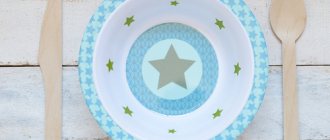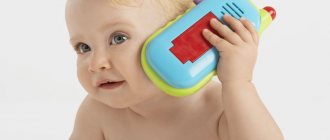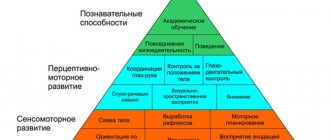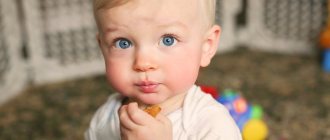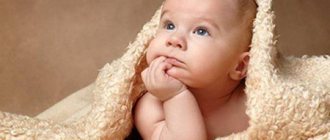Every parent is concerned about how well their baby is developing. However, there is no specific framework for development, because each child is individual, which means their development occurs differently: some begin to walk earlier, while others begin to talk. Therefore, you should not take the achievements of one child as a general indicator of development for another, because what one child can easily do is not always within the power of another. However, we should also not forget that there is a generally accepted set of skills that a child of two years should perform and know. We learn from the article what a baby should be able to do at this age.
Physical development of a child at 2 years old
Boys at 2 years old weigh approximately 13 kg, girls 12 kg. Boys' height is about 85-90 cm, and girls' height is 80-85 cm.
Children at this age are very active and love active games, running and jumping. At 2 years old, the child does not just run, but tries to overcome obstacles on the way, so the baby can easily step over objects up to 20 cm in height. The task of parents during this period is to encourage the activity of the baby and not to forget about safety, because at this age the baby is very unpredictable.
It is important to give the child more independence, for example, allowing him to dress himself, put on a hat or mittens, or tights. You can’t rush him, if something doesn’t work out, you just have to show him how to do it right again. Children at 2 years old are very smart.
Achievements in speech development
As for speech development, disputes always arise here. By the age of two, one child can already recite poetry on a par with adults, know the count to 10, the name of each close relative and the full address of residence, while another says nothing except “mom” and “dad.” In the second case, one cannot speak of a developmental deviation - due to many influencing factors, such speech development is considered the norm.
At 2 years old, a child should know about 200 words. His speech skills are improving, and this is manifested in the following:
- the child uses substitute words, replaces onomatopoeia, which he used previously, with the correct pronunciation;
- copies the speech of adults without understanding the meaning of words;
- This is the age of “whys” - children are actively interested in “what is this?”, “why is this happening?” etc.;
- often talks about himself in the third person;
- can form sentences of at least 3 words;
- expresses his thoughts, and does so coherently;
- knows how to distinguish antonyms;
- names the objects shown in the picture and can write a description of them;
- knows his name and the names of close people.
It is very important to address the child clearly, without babying or distorting words. If you introduce your baby to a new word, be sure to explain its meaning in a language that the baby can understand.
Psychological development of a child at 2 years old
The psyche at this age opens completely to understanding the world. Previously, the baby was also interested in everything, but it was more of an infantile curiosity influenced by instincts. At 2 years old, the child consciously explores the world and explores the space around him.
New skills are learned instantly and are often remembered for a long time.
Many children at this age can handle pencils, and this is a great time to spend more time being creative. The baby is already able to sit through short sessions with plasticine, paints, and pencils. You can and should get acquainted with various construction sets and mosaics. The baby learns to perform a number of simple logical operations; we need to encourage him to try to perform simple actions independently.
https://youtu.be/ti-FHbL9laA
Emotional characteristics of a second year child
Before the age of two years, the baby reacts emotionally only to those situations that he directly perceives, since he does not yet have imagination and ideas about abstract concepts. All emotions are equally intense, since all his desires are equally strong. He cannot make a choice, set priorities, or control his impulses. The function of managing the child’s behavior should be taken on by adults, who have praise and punishment in their arsenal.
Freedom of movement allows children to communicate with each other. At the same time, each of them behaves based on their own desires. This self-centered behavior is due to the fact that the toddler cannot put himself in the place of another and does not have the ability to empathize.
Children often use fits of rage to get what they want from their parents. To avoid such emotional blackmail, be sensitive to your child's needs in any situation. Try to avoid explosive attacks and use distractions as soon as you feel hysteria approaching. In some cases, it is better to let your child blow off steam and calm him down after the tantrum is over.
After the first birthday, most children lose their fear of strangers, but other fears may appear, such as dogs or cats, as well as other objects and situations that are associated with pain. Unfamiliar situations coupled with separation from family can cause severe anxiety and fear.
Skills of a child at 2 years old
Physical development includes assessment of motor skills. The main thing at the age of 2 years is coordination and coordinated movements. The better a child can manage and control his body, the easier it is for him to explore the world around him and master new activities. How coordinated the movements are depends on the development of fine and gross motor skills.
Moving the body in space is a gross motor activity, such as running or walking. At 2 years old children can:
- run;
- step on each step with one foot and go up and down the stairs;
- jump (up, jump over an obstacle, jump on one leg);
- march;
- hit the ball;
- walk backwards;
- stay on the crossbar.
Coordinated precise movements of the hands, which are reproduced together with vision - fine motor skills. For example, a child can choose from a row exactly the item he needs.
By age 2, most children can:
- draw a line (vertical);
- build a tower from 5 cubes;
- cut the paper.
Important: the main task for parents at this stage is to help the baby train coordination of movements and develop dexterity. Particular attention should be paid to fine motor skills. It has been proven that it is at this age that the development of fine motor skills is directly linked to the development of speech. Scientists have found that the area of the brain that is responsible for small movements of the hand is located next to the areas responsible for the development of speech.
Socialization of personality
By the age of two, the child is drawn to communicate with other children. And even if the child still speaks poorly, he has his own ways of making acquaintances and inviting another child to play.
For example, children often take another child by the hand, touch some part of his clothing, thus showing interest, or hold out a toy as a message “let's play.”
They form their own idea of how to behave in a team. Some intuitively, others “the hard way” begin to understand that it is better to share toys if you want to be accepted into the company and play with another child’s toys, that it is not worth fighting, because you can get back.
In 100% of cases, “conflicts in the sandbox” cannot be avoided at this age. What can you do, social experience does not appear on its own, but is formed in the process of communicating with others!
The process of establishing relationships with peers will be easier if the child sees friendly, calm communication between all family members in the family.
Also, the process of forming social experience will be less painful if parents show the child ways to peacefully resolve conflicts and find a compromise in communicating with others.
For example, show your child that you don’t have to snatch your toy back from the child, but offer to exchange toys for a while and play with his toy. This is how two kids learn to share at once.
Please note: it is more effective not to tell the child all this, but to show it with your own personal practical example.
Above we talked about the physical differences between two-year-old children of different sexes. The social behavior of boys and girls at this age is also noticeably different.
At about 2-3 years old, children begin to realize that they belong to a particular gender. The girls understand that they are like their mother, they can and love to dress up. The boys understand that they are like their dad and believe that when they grow up, they will be strong, brave and will be able to do everything. They choose “male” hobbies (technology, weapons, sports games).
Girls love to play with “humanoid” toys - dolls, and less often with animals.
Useful: How to teach your child to recognize geometric shapes in a playful way?
Boys more often prefer to play with technomorphic toys (vehicles, construction toys, weapons).
Differences are manifested not only in addiction to different activities, but also in behavior and communication with others.
Boys are more active, independent, act impulsively, quickly lose interest in activities, change activities, and are sometimes aggressive.
Girls are calmer, more careful, attentive, quickly get involved in the process, the game and retain interest in one type of activity longer.
Girls cope better with template, same-type tasks.
Boys often think outside the box and get creative.
Girls often ask adults questions in order to start communication and establish contact. They care about attention and communication.
Boys ask adults questions to obtain specific information. In other words, boys are focused on information, not the contact itself.
Girls evaluate others in relation to themselves. To earn a girl’s attention, you need to praise her, give her a compliment, and give her something.
Boys judge others by their skills. They are drawn to the person who will show them something new, interesting, teach them something, and play games with them.
Intellectual development
This area examines the development of memory, speech, thinking and perception. How developed these processes can be assessed according to several criteria:
- correct reaction to music, dancing or swaying to the beat of the melody;
- fulfilling simple requests in a few steps;
- repeating short nursery rhymes or telling them together with an adult;
- the position of the researcher, so the child often tries to disassemble or even break an object in order to study it;
- vocabulary up to 130 - 150 words (including passive);
- writing simple sentences or short phrases.
Motor development
Your child is good at holding a pen, pencil, felt-tip pen, or brush. He draws doodles, straight lines on a piece of paper. It's time to buy him paints and whatman paper. Add finger painting to your list of regular activities. He will be happy to dip them in paint and create his own children's masterpieces.
Knows how to unfasten clothes with zippers, buttons, and Velcro.
He easily clicks on the keyboard, presses phone buttons, inserts a charger or headphones into the socket.
Some talented kids struggle with tying their shoelaces. In general, the number of skills young parents demonstrate is how much they adopt.
Social development
For a 2-year-old child, it is important to communicate with peers. The baby reaches out to children his age and copies movements.
But more important is the acquisition of everyday skills. The following points are useful for social development:
- Meeting children on walks. Children do not yet know how to play on their own; adults must participate. It is especially important to teach play with others if your child will soon go to kindergarten.
- Teach your child to exchange toys.
- Parents should explain that they need to feel sorry for the other person if, for example, he fell. Expressing sympathy for another person.
- Teach your child to clean up his toys.
- Learn to dress yourself.
- Carry out the simplest tasks, for example, watering a flower.
- Wipe the table if you spill something.
Adviсe
- Young parents should pay attention to the development of fine motor skills of the baby, that is, give more activities for the hands. This way you stimulate his speech activity, memorization and pronunciation of more words.
- Provide the opportunity for your baby to develop physically. Jumping on a trampoline, crawling through a maze, outdoor games, for example, tag. – excellent options for strengthening muscles and mastering new body skills.
- Let him do things on his own more often, such as eating with a spoon or buttoning his clothes.
- Try to communicate more with your baby if you work outside the home. He will remember more words if he hears explanations and answers to his questions.
- Regularly read different fairy tales, stories, and poems to him. Play music with the sound of a variety of instruments.
Walk in the park and listen to the singing of birds, the rustling of leaves and grass, and the murmur of water. They have an extremely beneficial effect on the emotional, visual and auditory development of the baby. Plus, you set an example of interaction with nature, instilling love and respect for all living things.
Nutrition and daily routine at 2 years of development
Child development is also health control. A proper diet is very important in the first years of life. The diet must contain all the necessary vitamins and microelements that are so important for a small growing organism. A two-year-old child should receive approximately one and a half thousand kcal per day. Portions should not be large, but there should be a variety of food about five times a day.
The parents’ task is to teach the child to chew food well, use a spoon independently, and drink from a mug. Food should be presented in a way that is convenient for the baby, for example, vegetables and fruits can be cut into convenient slices.
If for some reason the child has not yet developed a daily routine, it is worth doing this. You need to get into the habit of going to bed and eating at the same time, this will help improve not only your appetite, but also ensure proper rest. For a 2-year-old child, daytime sleep is important, approximately 2-3 hours. And the total amount of time for sleep is approximately 12 hours.
You shouldn’t force yourself to stick to your daily routine. You can play around with everything, thereby explaining that the day begins with washing, brushing your teeth, breakfast, and so on until you go to bed. Games must be alternated with mandatory activities. Already at 2 years old, a child must be taught personal hygiene, for example, explain that hands must be washed every time before eating and after going outside.
For children of the second year of life, in addition to the pediatrician, a visit to the dentist is mandatory. You can't wait for dental problems to appear. It is best to monitor your oral health from childhood.
Psychomotor development of children aged 2.5 to 5 years. American Academy of Pediatrics
Each child develops differently, so it is impossible to say when exactly your child will master a particular skill. However, the developmental milestones described here will give you a general idea of what to expect from your child as he grows. Don't worry if your baby develops a little differently. It is important to remember that development is not a race. Some children do not reach each milestone at the same time as everyone else. This is especially true if they were born prematurely.
Monitor your progress. The most important thing is to make sure that your child is moving forward in his development. For example, your child should begin to pull himself up to stand and then begin to walk. Remember that children reach new developmental milestones at different ages.
You know your child better than anyone else. If you pay enough attention to it, you will see how well it develops. You will also understand if he needs even more attention/care.
( ed . “Age norms for the development of a child serve only as a guideline. For the development of a child, what is important is not the age at which he can do something, but the steps through which he consistently rises in his development” - L. Polinsky.)
What developmental achievements should be expected from a child aged 24 - 30 months (2 - 2.5 years)?
Motor Development: * Draws scribbles in a circular motion and can draw vertical lines * Runs well, occasionally falling * Walks up and down stairs independently * Stands on one leg without support (ed . - at least 1 second, DDST) * Rolls over one leg at a time page in a book
Development of language skills: * Speaks in 2-3 word sentences * Follows a simple 2-part instruction (ed. – “Put the cup on the table”) * Uses at least 20 words (including pronouns “he”, "she", "I")
Development of the cognition process, cognitive functions (learning, thinking, problem solving): * Reads books by turning pages and looking at pictures * Opens the door by turning the handle * Washes and dries hands * Feeds himself without getting too dirty
Social and Emotional Development: * Helps with simple household chores * Typically responds to comments about stopping something
What developmental achievements should be expected from a child aged 2.5 - 3 years?
Motor Development: *Rides (pedals) a tricycle *Cuts (uses) small scissors *Draws or copies (following a pattern) complete circles *Jumps up, balances on one leg (ed . - at least 2 seconds, DDST) * Climb stairs confidently/well * Runs easily Development of language skills: * Speaks clearly (clearly, most of the time) * Understands prepositions such as “in”, “on”, “under”, “near” * Connects sentences using “and”, “or”, “but” * Follows 2 or 3 step instructions * Can name common things (often used in everyday life) * Says name, age and gender * Calls friends by name * Says words as “I”, “me”, “we” and “you” and some plurals (cars, dogs, cats) * Conducts a conversation using 2 - 3 sentences
Development of the cognition process, cognitive functions (learning, thinking, problem solving): * Learn to use the toilet (toilet), as well as wash your face and hands * Can use buttons, levers and moving parts of toys for their intended purpose * Plays pretend (with dolls, animals and people) * Puts together puzzles of 3 or 4 pieces * Understands what "two" (plural) means * Copies a circle with a pencil or crayons * Turns pages in a book one at a time * Builds towers with more than 6 blocks * Screws and unscrews lids on containers or turns the doorknob
Social and Emotional Development: * Gives directions (orders) to other children * Plays certain role-playing games ("mom", "dad", "teacher") * Copies adults and friends * Shows affection to friends without prompting * Uses turning/rotating * Shows concern for a crying friend * Understands the meaning of the words "mine" and "his" or "hers" * Shows a wide range of emotions * Easily separates from mom and dad * May become upset with major changes in routine * Tries to dress and undress independently
Monitoring the child's development
Tell your pediatrician if you notice any of the following signs of possible developmental delay in your child by age 3 :
* Constantly falls or has trouble climbing stairs * Speaks in an unknown language or has very unclear/unclear speech * Cannot play with simple toys (e.g. simple puzzles/puzzles, turn a handle/lid) * Does not speak in 3 sentences words * Doesn't understand simple instructions * Doesn't pretend or play pretend * Doesn't want to play with other children or toys * Lacks eye contact * Loses skills he once had
What developmental achievements should we expect from a child aged THREE-FOUR years?
With your child's 3rd birthday, the period of the "terrible 2 years" officially ends and your child enters the "magic age" - from three to five - a time when the child's world is filled with fantasies born of his vivid imagination. Your child will mature in many ways over the next two years. Below are other achievements you can expect from your child:
Motor development * Jumps and stands on one leg for up to 5 seconds. * Jumps or takes a running long jump * Goes up and down stairs without support * Kicks a ball * Throws a ball up * Almost every time catches a ball that bounces off the ground or off a wall * Moves nimbly, both facing forward and backwards
Development of fine motor skills and hand movements * Copies square shapes from a model * Draws a person, depicting two to four parts of the body * Uses scissors * Draws circles and squares * Begins to copy large letters from a model * Pours, cuts under supervision, and purees (presses food)
Development of language skills * Distinguishes between the concepts of “same” and “different” (“same” and “different”) * Improves basic grammatical skills, Reads several letters * Speaks in sentences of 5-6 words * Speaks clearly enough - so that even strangers can understand him * Tells stories from everyday life * Follows a simple 3-part instruction * Knows some basic rules of grammar, such as using “he” and “she” correctly * Sings a song or poem and speaks from memory * Can say first and last name
Development of the cognition process, cognitive functions (learning, thinking, problem solving): * Correctly names some colors, Can count 5 or more objects when asked: “How many are there?” * Has a general understanding of counting and can know several numbers * Approaches problems from his own point of view * Begins to gain a sense of time * Complies with requests that require three actions * Recalls parts of a story * Distinguishes between the concepts of “same” and “different” * Buttons one or the other a few buttons * Typically looks both ways before crossing the road * Plays fantasy games * Dresses and undresses without assistance, except for tying/untying shoelaces * Washes face without assistance * Plays board or card games * Tells you what does he think will happen next in the book
Social and emotional development * Is interested in everything new * Teams up and interacts with other children * Plays “mom” or “dad” * Shows increasing creativity during fantasy play * Dresses and undresses himself * You can agree with the child about this or that a different way of resolving a conflict situation * Becomes more independent * Imagines different monsters when he sees incomprehensible images * Perceives himself as a whole person with body, mind and feelings * Often does not understand where the line between fantasy and reality lies * Protects children younger than himself * Prefers would rather play with other children than himself * Cooperates with other children * Talks about what he likes and what he is interested in
Monitoring the child's development
Tell your pediatrician if your child shows any of the following signs of a possible developmental disorder by age 4 .
*can't toss a ball *can't jump in place *can't ride a 3-wheeler *can't hold a crayon in his fingers *has trouble scribbling *can't stack 4 blocks on top of each other *still cries and clings to parents when they leave * shows no interest in games that require interaction * ignores other children * does not communicate with people who are not members of his family, ignores other children * does not use imagination in games * resists dressing, sleeping, using toilet * loses his temper, loses control, lashes out at people when angry or upset * cannot draw a circle according to a pattern * does not use sentences of more than 3 words * misuses the words “I” and “you” * cannot paraphrase favorite story * does not follow the 3-phase command * does not distinguish between the concepts of “same” and “different” (“same” and “different”) * does not use “I” and “you” correctly * speaks unclearly * loses the skills that he once possessed
What developmental achievements should we expect between the ages of 4 and 5?
Before you know it, a calm three-year-old child somehow quietly becomes a generator of energy, excitement, confusion, combativeness and completely unacceptable behavior. This may remind you of the trials and tribulations you went through when he was two. It is obvious that at this time a huge stream of creative ideas is bursting from children's minds and mouths. These behaviors and mindsets will help your child build a strong foundation for entering the world of kindergarten.
Let's look at some other achievements.
Motor development * Stands on one leg for 10 seconds or longer * Jumps, somersaults, may do somersaults * Swings, climbs (on something), Swings independently on a swing * Possibly jumps (over something)
Development of fine motor skills * Copies triangles and other geometric shapes * Draws a person with a body of at least 6 parts * Writes some letters, Prints his name * Dresses and undresses without assistance * Uses a fork, spoon and (sometimes) a table knife * Usually on his own takes care of using the toilet
Developing Language Skills *Remembers part of a story *Says phrases of more than five words *Uses the future tense *Tells long stories using complex sentences *Gives your name and address *Explains the meaning of familiar words *Recognizes most letters of the alphabet *Speaks very clearly *Uses the future time, for example, “Grandma will be here soon.”
Development of the cognition process, cognitive functions (learning, thinking, problem solving): * Can count 10 or more objects * Correctly names at least four colors * Better understands the concept of time * Knows about things used every day at home (money, food, appliances) ) *Uses the toilet without assistance *Knows the purpose of daily used items such as money and food
Social and Emotional Development * Wants to please friends * Wants to be like his friends * Agrees more easily with rules * Likes to sing, dance and put on plays * Demonstrates increasing independence, even able to visit immediate neighbors on his own * Aware of gender differences * Can differentiate between fantasy and fantasy reality * Sometimes persistent, sometimes very responsive * Shows leadership among other children * Plays dress-up and pretend play * Shows caring and compassion for others
Monitoring the child's development
Call your pediatrician's attention if your child shows any of the following signs of possible developmental delay by age 5.
* Acts unusual (very fearful or timid, very aggressive) * Cannot leave parents without strong protest * Easily distracted and cannot concentrate on one activity for more than 5 minutes * Has little interest in playing with other children * Does not respond to people at all or reacts only superficially. *Rarely uses imagination or imitation in play *Appears unhappy or sad most of the time *Not interested in new activities *Avoids or withdraws from other children and adults *Does not express a wide range of emotions *Has trouble eating, sleeping, or using the toilet *Cannot discriminate fantasy and reality * Appears unusually passive * Does not understand instructions that are two-part or use a preposition (“Put the cup on the table,” “Pick up the ball under the sofa”) * Cannot say his first and last name correctly * Does not use the plural in speech and past tense * Does not talk about daily activities and experiences * Can't build a six- to eight-pack tower * Feels uncomfortable holding a pencil * Has difficulty taking off clothes * Can't brush teeth, wash and dry/dry hands, or undress without help help * Doesn't draw pictures * Loses skills he once had
Primary sources: , , , , , ,
Educational games and toys for 2 years old
In the second year of life, the baby not only loves to play with his toys, he also wants to actively participate in the lives of adults. It is necessary to give him more freedom. For example, you can allow him to move the chairs as he likes, to rearrange something on a shelf or in his locker. If the room is safe and all dangerous objects have been removed, you can leave the child alone in the room for a short time.
Two-year-old children are quite assiduous. A child can be passionately engaged in an interesting activity for up to half an hour. He may even be interested in colored pencils or paints. It's time for parents to participate in this process; you can show how to draw simple shapes, help him first, and then let him try it himself. Of course, everything won’t work out right away and won’t be remembered, but if you repeat these actions every day, the baby will quickly learn everything.
Emotions
At two years old, you will not be surprised by the tears and hysterics of a child. This is how we now show our character.
A baby may shed tears if:
- Mom disappears from his field of vision.
- They refuse to fulfill his request.
- When another child takes his favorite toy.
You will hear hysterics in the following cases:
- If you are dragging your baby home, taking him away from friends and his favorite swing.
- Don't let your little one on a trampoline or other carousel. Especially if he sees other children frolicking there.
- You refuse to buy him the desired thing (toy, candy). In such cases, my nephew managed to fall to the floor and began to kick his feet.
Recommendations for parents in 2 years of child development
During this period, you need to pay as much attention to the child as possible. At 2 years old, children are all developed approximately equally, but after six months it will be clearly noticeable how much time was devoted to each child separately. It is at this time that the child is ready to “absorb” everything that the adult offers him. The concept of responsibility, hygiene, aesthetics and much more is much easier to instill from early childhood.
Baby development at 2 years old - Video:
width=”560″ height=”315″ frameborder=”0″ allowfullscreen=”allowfullscreen”>
Cognitive skills and abilities
At the age of two, thinking, memory, attention and imagination develop intensively, the baby strives to learn new things and imitate an adult. He is interested in all objects and actions with them. So, what should a child of 2 years know:
- recognize objects by description and characteristics, distinguish them by size, shape, etc.;
- show and name familiar objects in the picture;
- know and distinguish basic and some shade colors, as well as the shapes of objects;
- collect a pyramid of 6 rings, a nesting doll;
- group objects according to their main characteristics;
- remember and repeat movements and words in the required sequence, memorize short poems, songs, dances;
- assemble cut pictures from 2-4 parts;
- know what “little” and “many” are;
- find identical objects, patterns and drawings;
- know what “above”, “below”, “left”, “right” are;
- find a whole object by its part, select a shadow to an object;
- it’s easy to play hide and seek, games “What’s missing” and “What’s new”;
- build a storyline in the game, select replacement items and the necessary characters;
- perform actions with objects in a logical sequence.
“A child strives to repeat after an adult, to learn something new. He gets down to business with enthusiasm.”
It is important to support this initiative, and not suppress it, not scold for mistakes, but show how to do it right. This is an excellent period to accustom your baby to work. The baby imitates the adult, copies him, so parents need to be more attentive to themselves.

